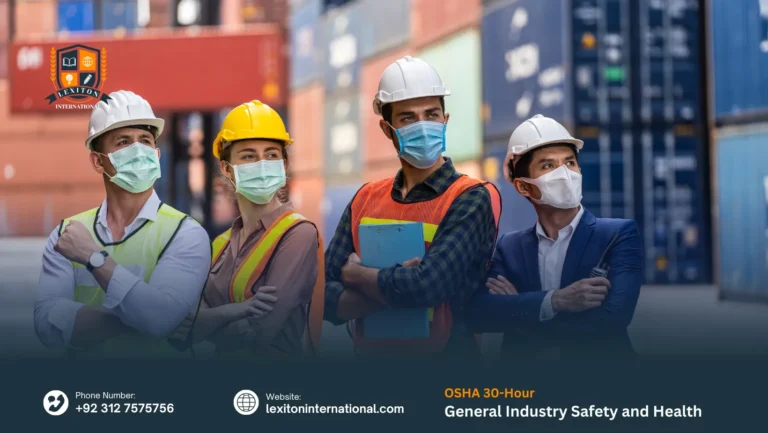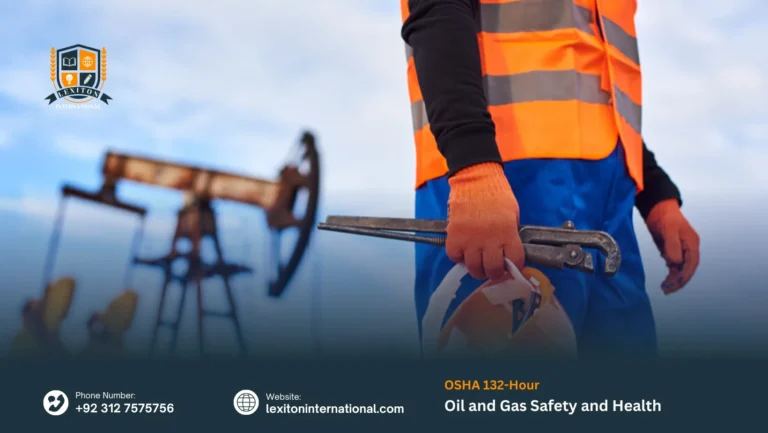Advance your expertise with the OSHA 132-Hour General Industry Safety and Health course, a comprehensive program designed for professionals committed to workplace safety and regulatory compliance. This advanced training equips participants with in-depth knowledge of occupational health, risk management, and safety protocols, preparing them to address the complex challenges of modern industrial environments. By completing this course, learners gain practical skills and strategic insights that make them invaluable assets to their organizations while enhancing career growth opportunities in the field of industrial safety.
Unlike basic safety programs, the OSHA 132-Hour course provides a rigorous and detailed exploration of hazard identification, compliance frameworks, and accident prevention strategies across multiple sectors within general industry. Participants learn to assess workplace risks, implement effective safety measures, and navigate both OSHA regulations and international standards. The curriculum emphasizes real-world applications, ensuring learners can directly apply their knowledge to create safer, more efficient, and legally compliant work environments.
This course is particularly suited for safety managers, compliance officers, industrial supervisors, and health and safety professionals seeking to advance their careers and leadership capabilities. Beyond technical expertise, participants develop skills in proactive safety management, informed decision-making, and fostering a culture of workplace health and safety. Completing the OSHA 132-Hour General Industry Safety and Health course strengthens individual competence, enhances organizational resilience, and supports sustainable operational success, making it a vital investment for professionals and organizations dedicated to excellence in occupational safety.
The OSHA 132-Hour General Industry Safety and Health course is designed for professionals at various stages of their careers, from early-career safety personnel to experienced health and safety managers. To ensure participants can successfully engage with the advanced content, the following entry requirements apply:
- Educational Background: Participants should have at least a high school diploma or equivalent. A background in engineering, occupational health, industrial management, or related fields is advantageous but not mandatory.
- Professional Experience (Recommended): While not strictly required, prior experience in industrial settings, health and safety roles, or compliance functions will help learners better relate to practical scenarios and case studies.
- Basic Safety Knowledge: Participants should have a general understanding of workplace safety principles, OSHA standards, or industrial safety protocols.
- Language Proficiency: As the course is delivered in English, learners should be proficient in reading, writing, and comprehension to fully engage with course materials and assessments.
- Digital Literacy: Basic computer and internet skills are required for accessing online resources, submitting assignments, and participating in virtual training modules.
- Commitment to Learning: Participants should demonstrate a strong motivation to develop advanced safety and compliance expertise and the ability to apply knowledge in real-world industrial environments.
Mandatory Units
This qualification, the OSHA 132-Hour General Industry Safety and Healths, consists of 16 mandatory units.
The OSHA 132-Hour General Industry Safety and Health course is an advanced training program designed to provide participants with in-depth knowledge, practical skills, and compliance expertise essential for managing safety and health across diverse industrial environments. This comprehensive program equips learners with the ability to identify hazards, apply OSHA standards, implement effective safety controls, and lead workplace safety initiatives with confidence. Through structured study units, learners gain the tools necessary to strengthen compliance, reduce risks, and promote a culture of safety excellence within their organizations.
1. Introduction to OSHA and General Industry Safety
- Understand the mission and role of OSHA in regulating workplace safety and health.
- Identify OSHA standards and regulations applicable across general industry sectors.
- Explain the rights and responsibilities of employers and employees under OSHA guidelines.
2. Walking and Working Surfaces
- Identify and assess hazards associated with walking and working surfaces in industrial environments.
- Implement preventive measures to minimize slips, trips, and falls.
- Conduct workplace inspections to ensure compliance with OSHA safety standards.
3. Electrical Safety Standards
- Recognize electrical hazards and apply OSHA electrical safety requirements.
- Implement safe practices for working with electricity and electrical equipment.
- Conduct audits and inspections to mitigate risks and maintain compliance.
4. Hazard Communication
- Interpret OSHA’s Hazard Communication Standard (HCS) and its workplace applications.
- Develop and implement a hazard communication program with proper labeling and Safety Data Sheets (SDS).
- Train employees in safe chemical handling and hazard communication protocols.
5. Personal Protective Equipment (PPE)
- Assess workplace hazards and determine the appropriate PPE required.
- Ensure correct use, maintenance, and storage of PPE.
- Train employees on proper PPE practices to protect against workplace risks.
6. Fire Safety and Prevention
- Develop and enforce fire prevention and emergency response procedures.
- Conduct fire risk assessments and drills to prepare employees effectively.
- Ensure workplace compliance with OSHA fire safety regulations.
7. Machine Guarding and Lockout/Tagout
- Identify hazardous machine operations and apply effective guarding techniques.
- Develop and implement lockout/tagout procedures to control hazardous energy.
- Train employees on safe machine operation and energy control procedures.
8. Ergonomics
- Identify ergonomic risks and apply ergonomic design principles.
- Implement solutions to reduce musculoskeletal disorders and injuries.
- Conduct ergonomic assessments to enhance worker comfort and productivity.
9. Hazardous Materials and Waste Management
- Identify hazardous materials in the workplace and evaluate associated risks.
- Apply safe handling, storage, and disposal methods for hazardous substances.
- Ensure compliance with OSHA’s HAZWOPER standards when applicable.
10. Industrial Hygiene and Occupational Health
- Conduct workplace exposure assessments for chemical, physical, and biological hazards.
- Apply control measures to reduce occupational health risks.
- Establish and maintain occupational health programs to protect workers.
11. Confined Spaces
- Identify confined spaces and associated hazards in industrial environments.
- Develop and implement confined space entry and permit-required procedures.
- Train employees on safe entry, monitoring, and emergency rescue protocols.
12. Emergency Response and Preparedness
- Develop emergency response plans tailored to workplace hazards.
- Conduct emergency drills and simulations to strengthen readiness.
- Train employees to respond quickly and effectively to emergencies.
13. Accident Investigation and Recordkeeping
- Perform thorough accident investigations to identify root causes.
- Implement corrective actions to prevent recurrence of incidents.
- Maintain OSHA-compliant accident records and documentation.
14. Health and Safety Management Systems
- Understand the components of effective occupational safety management systems.
- Design and implement systems that align with organizational needs.
- Continuously assess and improve safety performance through audits and corrective actions.
15. Safety and Health Training Techniques
- Develop and deliver impactful training programs for employees at all organizational levels.
- Use adult learning strategies to improve employee engagement and retention.
- Evaluate training effectiveness and make adjustments to meet evolving safety goals.
16. Special Topics and Emerging Issues
- Stay updated on evolving OSHA regulations and new safety challenges.
- Address workplace violence prevention, pandemic preparedness, and new safety technologies.
- Proactively assess and mitigate risks associated with emerging workplace hazards.
The OSHA 132-Hour General Industry Safety and Health course is designed for professionals who want to enhance their expertise in occupational safety, compliance, and risk management. It is suitable for a diverse range of learners across industries who are responsible for creating and maintaining safe, compliant, and efficient workplace environments.
Safety and Compliance Professionals
- Safety Managers and Officers responsible for developing and implementing workplace health and safety programs
- Compliance Officers ensuring adherence to OSHA regulations and industry-specific safety standards
- Industrial Hygienists monitoring workplace conditions and managing environmental hazards
- Environmental Safety Specialists focusing on pollution control, sustainability, and hazard mitigation
- Professionals seeking to upgrade technical safety knowledge and earn advanced certification for career growth
- Individuals aiming to improve risk assessment, incident reporting, and emergency response skills
- HR and administrative professionals involved in occupational health and safety compliance
- Learners preparing to lead workplace safety audits and ensure regulatory adherence
Supervisors and Industrial Leaders
- Team leaders, supervisors, and operations managers in manufacturing, logistics, construction, and industrial settings
- Individuals tasked with overseeing workforce safety and ensuring safe operational procedures
- Leaders seeking to develop proactive safety management strategies and foster a culture of compliance
- Managers responsible for accident prevention, hazard identification, and safety training
- Professionals aiming to implement OSHA best practices and align team operations with safety standards
- Supervisors who want to enhance leadership skills in high-risk or industrial environments
- Those tasked with coordinating cross-functional safety initiatives and employee engagement
- Individuals looking to strengthen decision-making and accountability in workplace safety programs
Career Changers and Aspiring Safety Professionals
- Individuals transitioning into occupational safety, industrial hygiene, or compliance roles
- Professionals seeking internationally recognized OSHA certification to enhance career mobility
- Learners aiming to gain hands-on, practical skills in hazard management and accident prevention
- Career changers who want to understand regulatory frameworks and safety standards across industries
- Those looking to build expertise in risk assessment, emergency planning, and workplace inspections
- Professionals seeking new career pathways in safety consultancy, compliance auditing, or risk management
- Individuals wanting to strengthen problem-solving and analytical skills for safety challenges
- Learners motivated to position themselves as valuable contributors to organizational safety culture
Organizations and Corporate Teams
- Companies seeking to train employees in advanced health and safety practices
- Teams responsible for hazard identification, accident prevention, and compliance auditing
- Departments aiming to strengthen organizational resilience and reduce workplace incidents
- Businesses looking to improve operational efficiency through safety management
- HR and administrative teams supporting occupational health compliance
- Organizations aiming to align workplace procedures with OSHA standards and international regulations
- Managers seeking structured training programs to develop internal safety leaders
- Corporations wanting to enhance workplace culture focused on safety, accountability, and employee well-being
The OSHA 132-Hour General Industry Safety and Health course is ideal for anyone looking to build a comprehensive understanding of industrial safety, lead effective safety initiatives, and ensure full regulatory compliance, making participants indispensable to their organizations while advancing their professional careers.
Completing the OSHA 132-Hour General Industry Safety and Health course provides learners with a strong foundation to advance their careers in occupational safety, compliance, and risk management. Graduates gain the knowledge, skills, and certification necessary to pursue higher-level roles, specialized functions, and further professional development.
Higher Education and Certification Opportunities
- Enrol in advanced safety and health management programs at professional or postgraduate levels
- Pursue certifications in industrial hygiene, risk management, or environmental safety
- Gain eligibility for internationally recognized occupational safety certifications
- Prepare for specialized courses in emergency response, fire safety, or hazardous materials management
- Enhance academic qualifications for leadership roles in safety and compliance
- Build a foundation for continuing professional development and lifelong learning
- Access global programs for occupational health, safety leadership, and regulatory compliance
Career Advancement Opportunities
- Qualify for roles such as Safety Manager, Safety Officer, Compliance Officer, or Industrial Safety Specialist
- Pursue leadership or supervisory positions in manufacturing, construction, logistics, and industrial sectors
- Gain opportunities in risk assessment, hazard management, and workplace audit roles
- Strengthen professional credentials for promotion or international assignments
- Access positions in consultancy, project management, or occupational health advisory services
- Develop a competitive edge for senior safety, compliance, and operational management roles
- Contribute to enhanced organizational safety culture and regulatory compliance
Skills Development and Professional Growth
- Advance expertise in hazard identification, accident prevention, and risk mitigation
- Develop strategic decision-making and leadership skills in safety-critical environments
- Gain confidence in emergency planning, safety audits, and compliance management
- Build practical knowledge applicable across multiple industrial sectors
- Enhance problem-solving and analytical capabilities for complex safety challenges
- Strengthen team coordination and workforce safety management skills
- Prepare for continuous professional development and specialized safety certifications
Specialized Career Pathways
- Work in environmental, industrial, or corporate safety and compliance roles
- Engage in training, consultancy, or advisory positions in occupational safety
- Implement safety systems, risk assessments, and compliance programs for organizations
- Contribute to policy development, employee safety education, and workplace audits
- Explore opportunities in emergency response, hazard management, and sustainability projects
- Take up roles in international organizations or global safety compliance initiatives
- Position yourself as a subject matter expert in occupational health and safety
Leadership and Management Opportunities
- Prepare for senior management positions such as Safety Director or Compliance Lead
- Lead organizational safety initiatives and manage cross-functional teams
- Influence safety policies, training programs, and workplace culture
- Develop skills to coordinate large-scale safety audits and risk assessments
- Strengthen abilities in ethical decision-making, regulatory compliance, and operational oversight
- Gain recognition as a strategic safety professional in your organization
- Lay the foundation for executive-level career progression in health and safety management
The OSHA 132-Hour General Industry Safety and Health course is not only a qualification but a gateway to career growth, leadership development, and global opportunities in occupational safety. Graduates are well-equipped to advance to higher roles, specialize in key areas, and lead initiatives that enhance workplace safety and regulatory compliance across industries.
Curious About This Course?





